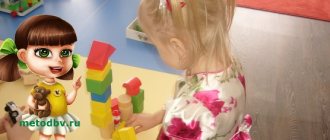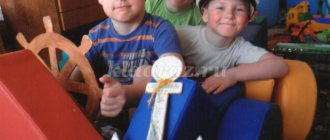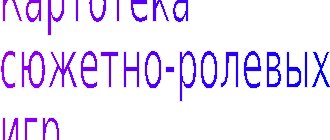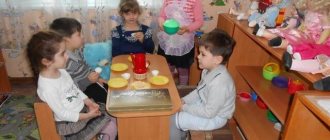Salon. Summary of plot-role-playing games in all age groups
10
younger group………………………………………………………………………………..2
- Summary of the role-playing game “Barbershop” in the middle group……………………………………………………………………………………………………………4
- Summary of the role-playing game “Barbershop” in the senior group…………………………………………………………………………………………………………………6
- Summary of the role-playing game “Barbershop” in a preparatory school group…………………………………………………….8
Summary of the role-playing game “Barbershop” in the second junior group.
Educational program: "Rainbow".
Age group: second youngest. Topic: "Hairdressing salon". Preliminary preparation:
Conversation about the profession of a hairdresser using illustrations.
Review of illustrative material on the topic. Equipment:
dolls, apron, cape, mirror, brush, bottles, combs, hairpins, bows, a set of special toys “Children's hairdresser”.
Source:
Gubanova N.F.
Development of gaming activities. Second junior group. – M.: Mosaika-Sintez, 2014. Goal:
Expanding children’s knowledge about the work of a hairdresser and the relationship between a hairdresser and clients.
Objectives: Developmental:
Development of dialogical speech, enriching vocabulary.
Develop creative imagination, promote joint development of the game. To liberate children, to facilitate their unification into a playing group. Educational:
To cultivate a sensitive, attentive attitude towards each other.
Formation of arbitrariness of gaming behavior. Educational:
Expanding children's understanding of the profession of hairdresser.
Teach children to take on a role and perform appropriate play actions. Use hairdresser tools in games and name them. Structural components of the game. Plot:
a hairdresser combs his hair and cuts it.
A mother and her daughters went to the hairdresser. The hairdresser combs your hair, refreshes you with cologne, and asks you to look in the mirror. The master is polite with clients. Playing roles:
hairdresser, visitors.
Game actions:
the hairdresser combs the hair, cuts it, dries the hair with a hairdryer, braids the girls’ hair, invites them to look in the mirror.
Visitors thank you for your work. Game rules:
treat toys with care, play without interfering with each other.
Playful use of objects: use in play of substitute toys, attributes for acting, mirrors, combs and brushes cut from soft plastic or linoleum. Real relationships between children: children play alone, do not distribute roles and play material, and only show interest in the play of their peers. Playful relationships between children unfold on the basis of the relationship between the hairdresser and visitors. Pedagogical support for the game involves organizing joint games between the teacher and children, in which new skills and new content are learned. Predicted results:
Reflection in the game of impressions of visiting a hairdresser.
Building friendly and friendly relationships during the game. Interest in the game, the general concept of the game plot, coordination of the actions of the players; performing game actions. Game development
: give advice, suggestions on using substitute items in the game.
Summary of the role-playing game “Barbershop” in the middle group.
Educational program: "Rainbow".
Age group: middle. Topic: "Hairdressing salon". Preliminary preparation:
The teacher's story about the profession of a hairdresser, about work in a hairdresser.
Examination of paintings, photo illustrations about the work of a hairdresser. Looking at magazines, an album with hairstyle samples. Conversation with children “How I went to the hairdresser with my mother.” Equipment:
robe for the hairdresser, cape for the client, hairdresser's tools - comb, scissors, bottles for cologne, varnish, hair dryer, etc.
Source:
Komarova N.F.
Comprehensive guidance for role-playing games in kindergarten. – M.: Scriptorium, 2010. Goal:
to introduce children to the profession of a hairdresser, to cultivate a culture of communication, to expand children’s vocabulary.
Objectives: Developmental:
Continue to develop role-specific speech.
Developing in children the ability to jointly develop a game, to coordinate their own plans with the plans of their peers. Educational:
Develop polite behavior towards each other. Continue to develop the ability to play together, in small groups.
Educational:
Learn to independently develop the plot.
Learn to independently distribute roles, act according to the role you take on. Learn to independently select substitute items and use them. Structural components of the game: Plot:
the teacher offers to look into the hairdresser, it is light and interesting here: mirrors.
Perfume, and chairs, the hall is large. In the hairdresser there is a master who does hairstyles. But before you go to the hairdresser, you need to sit and wait your turn. Playing roles:
hairdresser, clients.
Game actions: putting a cape on the client, combing his hair, cutting his hair, washing his hair, drying with a towel, drying with a hairdryer, tying ponytails, pinning hairpins, while the client’s hair is drying, you can offer to look at a fashion magazine. The game rules require that hairdressers and visitors comply with the rules of cultural behavior, that the game be completed with the one with whom they started playing, and that the toys be kept in order. The playful use of objects is a variety of subject material that is used in the game. Composing a room model from modules and chairs. Using a variety of construction sets to replace objects. Selection of toys, substitute items. Real relationships between children: children agree on the plot of the game, evaluate each other’s game actions. Playful relationships between children unfold on the basis of the relationship between the hairdresser and visitors. Pedagogical support for the game involves organizing joint activities and co-creation between the teacher and children in preparation for the game: accumulating content for games, modeling possible game situations. Predicted results:
Manifestation of one’s own initiative in the use of substitute items and elements of mummery
.
Enriching children's personal experience; Formation of children's ideas about the surrounding reality; The development of play involves a gradual transition from joint activity to independent activity with peers.
Summary of the role-playing game “Beauty Salon” in the senior group
Educational program: "Rainbow".
Age group: senior. Topic: “Hairdressing”. Preliminary preparation:
Excursion to the hairdresser.
Observing the work of the master. Reading stories by B. Zhitkov “What I Saw”, S. Mikhalkov “In the Hairdresser”. Collect attributes for the game: used clean boxes and jars of creams, perfumes, deodorants, shampoos. Ethical conversation about the culture of behavior in public places. Equipment:
Homemade albums with hairstyle samples, doll combs, hair dryers, curlers, curling irons;
small unbreakable bottles for perfumes and shampoos (designed in the form of fruits, vegetables, funny figures of people). Source:
Solntseva O.V.
A preschooler in the world of role-playing games. Accompanying children's story games. – M.: Rech, 2010. Goal:
formation of children’s social experience through play activities
Objectives: Developmental:
Independently create a play environment for the intended purpose.
To contribute to the formation of the ability to creatively develop game plots. Develop a desire to set various game problems and choose ways to solve them. Educational:
Fostering a culture of behavior in public places, respect, polite treatment of elders and each other, teaching gratitude for the help and service provided.
Educational:
Expanding and consolidating children’s knowledge about the work of a hairdresser in the “Barbershop”.
Expanding children's understanding of their parents' professions and applying them in the game. Teach to use attributes, toys, objects variably, and distribute them among children in accordance with roles. Structural components of the game: Plot:
The doll Katya comes to visit the children.
She meets all the children and notices a mirror in the group. The doll asks the children if they have a comb? Her braid has come undone and she would like to comb her hair. The doll is offered to go to the hairdresser. It is clarified that there are several halls there: women’s, men’s, good masters work in them, and they will quickly put Katya’s hair in order. Game roles:
women's hall master, men's hall master, clients, cashier.
Game actions: combing your hair, cutting your hair, washing your hair, blow-drying, spraying with perfume, tying ponytails, curling with curlers, putting masks on your face, applying varnish, paying at the checkout, while the client’s hair is drying, you can offer to look at a fashion magazine, waiting clients can drink coffee, tea and also look at magazines. The game rules require that hairdressers and visitors follow the rules of cultural behavior in public places, treat salon workers and other visitors with respect, speak calmly and kindly to a friend, and do not interfere with a friend’s game. Playful use of objects - the use of substitute objects made of various materials, attributes for mummers, construction of room modules. Real relationships between children: children play out the plot of the games, agree among themselves about the game, and control the implementation of the rules. Playful relationships between children unfold on the basis of the relationship between the salon master and the visitor, the cashier and the visitor. Pedagogical support for the game: creative creation of an environment for the game. Predicted results:
Development of verbal communication of those playing. Formation of children's ideas about social reality.
Expanding the range of role-playing activities in children. The development of the game can follow the line of inclusion in other game themes. Summary of the role-playing game “Barbershop” in the preparatory school group
Educational program: “Rainbow”.
Age group: preparatory. Topic: "Hairdressing salon". Preliminary preparation:
Children visit the hairdresser with their parents.
Children's stories about what they did at the hairdresser. Ethical conversation about the culture of behavior in public places. Looking at an album with hairstyle samples. Didactic game “Let’s comb the doll’s hair beautifully.” Making game attributes with children with the involvement of parents (robes, peignoir, towels, checks, money, etc.) Making an album “Hairstyle Models”. Equipment
: mirror, set of combs, razor, scissors, hair clipper, hair dryer, curlers, hairspray, cologne, album with hairstyle samples, hair dye, bathrobes, peignoir, towels, money, mop, buckets, rags for dust, for floors.
Source:
Ivakina I.A.
Guiding creative role-playing games for preschoolers. – Penza, 1995. Goal:
development of independent gaming activity in a group of peers.
Objectives: Developmental:
Development of cognitive abilities and coherent speech.
Each child develops a desire to show initiative during the game itself and at the preparatory stage: come up with a storyline, combine and coordinate options for plot development with peers, offer game events to play partners. Development of memory, thinking, imagination, emotional responsiveness to music. To liberate children, to facilitate their unification into a playing group. Educational:
Continue to develop in children an understanding of the need to comply with the rules and norms of ethical behavior.
Cultivating sensitivity and attention. Developing cultural behavior skills in a team and society. Educational:
Enrich the gaming experience of each child through participation in integrative activities (cognitive, speech, productive), including play.
Continue to develop the ability to combine thematic plot blocks into a single game plot. Learn to develop a storyline based on a modern role-playing game. Structural components of the game: Plot
: Visitors politely greet the hairdresser, ask for a haircut, consult with the hairdresser.
The master of the women's hall combs and cuts hair. The master is polite with clients. He combs, cuts, blow-dries his hair, and offers to look in the mirror. The master of the men's room - cuts hair, shaves, refreshes with cologne. Speaks politely and affably. Clients pay at the cash register and thank you for the services. The cashier knocks out checks. The cleaning lady sweeps and changes used towels. Playing roles:
visitors, hairdressers, cashier, cleaning lady.
Game actions:
the hairdresser receives the order, does the hairstyle.
The cashier accepts payment for the service, gives change, and writes about the service in the journal. The cleaning lady cleans the room, changes towels, and washes instruments. Visitors place an order and pay for it. Game rules:
distribute game material without conflicts, follow the rules of etiquette, be polite and helpful.
Playful use of objects: selection of toys, substitute objects made of various materials, attributes for acting. Real relationships between children: children monitor compliance with the rules, make comments, and agree among themselves about the game. Play relationships between children develop on the basis of the relationships between participants in play roles. Pedagogical support for the game involves creating conditions for children’s independent initiative and creative play activities. Predicted results:
Building friendly and friendly relationships during the game
.
Interest in the game, the general concept of the game plot, consistency in the actions of the players;
performing game actions .
Showing your own initiative in using substitute items and elements of mummery
.
The development of the game should be directed along the line of combining it with other plots and connecting to them.
MAGAZINE Preschooler.RF
Summary of a role-playing game for the senior group “Beauty Salon”- Babynina Tatyana Nikolaevna
- Moroz Ekaterina Alexandrovna
- Kovalenko Marina Viktorovna
Teachers of the MDOU "Combined kindergarten No. 19, Razumnoye village, Belgorod district, Belgorod region"
Project participants: teacher and senior children.
Goal: to develop in children the ability to play the role-playing game “Beauty Salon” .
Tasks
Educational: learn to combine knowledge obtained from different sources, reflect it in a single plot of the game; encourage children to independently assign roles and prepare the necessary conditions;
Developmental: develop the ability to coordinate game storylines and role-playing actions, agree on a sequence of joint actions.
Educational: to cultivate a culture of behavior in public places, respect, polite treatment of elders and each other, teach gratitude for the help and service provided.
Roles: administrator, manicurist, hairdresser, makeup artist, clients, cleaner.
Equipment: building material, mirror, combs, shampoo bottles, curlers (caps from old felt-tip pens), game set for a hairdresser; wallet, money (papers, mosaic pieces, lotto chips), phone (brick), bag (for the client); pen, cash register, money, fashion magazines (for the administrator); files (sticks), cotton swabs and disks, bath, jars and bottles (skittles); robe, scarf, gloves, bucket, basin, mop (stick); game set for makeup artist.
Preliminary stage.
Conversation with children: “What do they do in a beauty salon?”
Questions:
— what kind of halls are there?
— what types of work are carried out there? (haircut, hair wash, manicure, makeup, hair dyeing, hair styling, etc.)
- How should you behave in a beauty salon?
Reading fiction: S. Mikhalkov “In the Barber Shop” , M. Skrebtsova “The Wonderful Hairdresser” , E. Uspensky “A Scary Story” .
Excursion to a beauty salon. Observing the work of craftsmen. Looking at fashion magazines and catalogues.
Educational games:
Word games with objects: “What the masters can do” ; “Who needs what for work?” ; “I know 5 items that I use...” (administrator, hairdresser, makeup artist, manicurist)
Imitation games: “Guess by actions” ; “We won’t say what we saw, but we will show what we did . Games - dialogues: “Talking on the phone” ,
Creation of the workshop “Young Beauty Salon Designer” : signs “Beauty Salon” , signs for the names of the rooms; making friezes “Fashionable hairstyles” , “My fashionable image” , “Beautiful marigolds” .
Selection of materials for the game, preparation of scenery and attributes.
Progress of the game.
There are stands on the carpet with a red ribbon tied between them.
— Guys, the Defender of the Fatherland Day holiday is coming soon! . This is the holiday of your dads, grandfathers and our boys - future soldiers. Girls, do you want our boys to enjoy this holiday? Where can I get my hair cut, my hair done, my nails done, my makeup applied?
- In a beauty salon.
— Today the “Beauty Salon” opens.
-And the right to cut the ribbon will be given to the one who gives the most definitions for the word soldier and warrior (what is he?), I give incentive tokens for the correct answer. Whoever has the most tokens will cut the ribbon.
Distribution of roles.
- Children, remember we talked to you about who works in the beauty salon?
Who will work in our beauty salon? Who will do the hair and makeup for our fashionistas on our boys' day?
Intended roles:
- Hairdresser (does hair, washes hair, cuts hair).
- Manicurist (does manicure).
- Administrator (the teacher takes on this role).
- Cleaning lady (cleans the room, changes towels).
- Makeup artist (does makeup).
- Clients.
— While our girls are visiting the beauty salon, our boys will be constructing a “Dance Floor” from large building material (the boys go off to make a round area for half the group for the ball)
Playing out storylines.
- Children wear special clothes. They take their jobs.
- All clients wait on chairs for their turn.
- The first client comes in. Approaches the administrator. He asks if he can get a manicure.
- The administrator takes the client to the master.
- Manicurist. Processes tools, files nails, paints, writes out a receipt.
- The client thanks the technician and goes to pay the receipt to the administrator.
- The administrator knocks out a check and offers to visit the salon again.
- The second client goes to the hairdresser. The hairdresser clarifies. What kind of haircut or styling will be done? He does his hair and writes out a receipt.
- The cleaning lady sweeps the floor and changes the towels.
- The administrator reports that a new vacancy has appeared for “makeup artist” .
- Another storyline arises, the role of a makeup artist is added.
- He calls, the administrator picks up the phone, and they ask him if he can come to an appointment with a makeup artist. The administrator replies that a makeup artist’s office has opened and that you can come, they will be glad to see him.
- Makeup artist waiting for a client, preparing his workplace.
- A client arrives, the administrator greets him and escorts him to the master.
- The master does makeup, paints eyes, eyelashes, applies powder. Issues a receipt.
- The client thanks the master, goes to pay the receipt to the administrator and makes an appointment to have his hair done by the hairdresser.
The game continues until all the girls (clients) visit the beauty salon.
- New story: girls, after the beauty salon, go to a party with the boys.
The final stage
- Capturing children in photographs;
- Discussion of the game;
- Collection of equipment and attributes.
| Next > |
How do you like my new image?
I got my hair cut for spring and dyed my hair creatively.
Before that, I wore a completely different hairstyle with her, I looked like Yulia Menshova... But the hair grew back and this is what happened to my head), but this is so little about myself
I wonder who I remind you of with this hairstyle? What do you say?
By the way, it was not in vain that I started talking about haircuts and dyeing: today I want to tell you what attributes a group should have for the role-playing game “Barbershop”. It seems that all educators should know such obvious things, but it turns out that young specialists experience difficulties arranging thematic corners for role-playing fun. Many beginning teachers are either embarrassed or do not want to look like unqualified teachers and therefore do not ask for help from a methodologist or senior colleagues. Young people want to do everything on their own.
Well, let us help you collect the necessary attributes of the role-playing game “Barbershop”!
By the way, there are excellent didactic materials (according to the Federal State Educational Standard) in the form of colorful cards, which will not only help in planning joint socializing activities of children and the teacher, but will also be useful during thematic conversations, classes, and observations.
Regarding the question: whether to sew overalls and capes for a children's barber shop yourself or buy ready-made ones, I personally prefer factory-made products that meet sanitary and age standards for children's institutions. On the Internet there are very beautiful attributes of the story game “Barbershop” at absolutely inexpensive prices.






